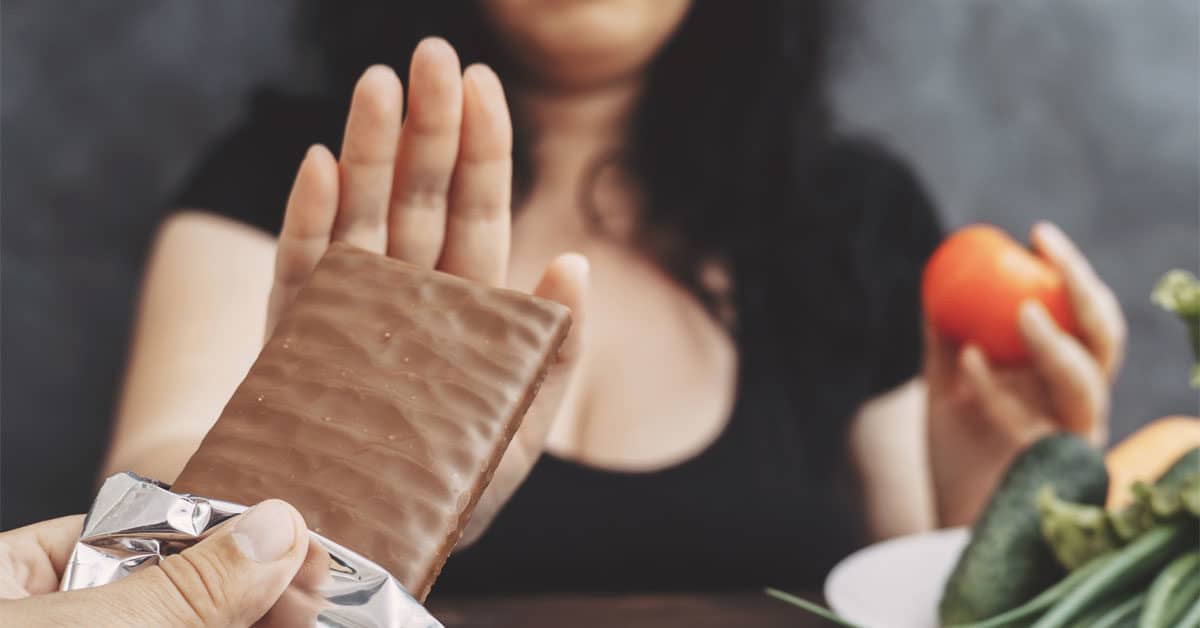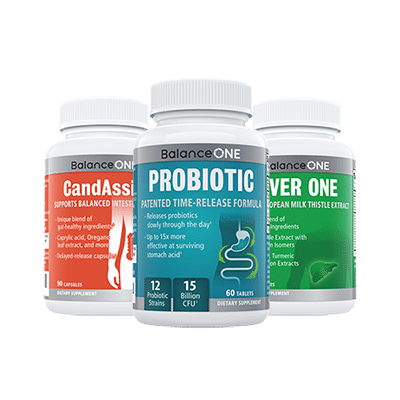Sugar Withdrawal: What Happens When You Give It Up?

Do you have a sweet tooth that just won’t go away? Do you dream about cookies and chocolate bars when you’re eating a healthy salad? Or do you forgo the salad entirely and just EAT the cookies and chocolate bars?
Well, as guilty as you feel for being a sugar fiend, it’s not entirely a lack of willpower that’s to blame. New research has suggested that our brains may in fact become so tolerant of sugar that we need more and more to feel good.
It appears that sugar addiction is very similar to nicotine and heroin addiction. Our brain’s “reward pathway” is wired in a way that makes us dependent on certain pleasures. The neuro-chemicals released when we eat sugar – and our subsequent behavior – suggests that sugar is as addictive as serious drugs.
So, what happens when we give it up?
Table Of Contents
Why Do We Get Addicted To Sugar?
Neuroscientists explain that when we eat, our body treats food as a kind of reward. The survival of the human race depends on food, which is why eating is a pleasurable activity. Just like socializing with people and having sex! Our species has been wired so that we will continue reinforcing and repeating these ‘survival’ behaviors.
Evolution has resulted in something called the mesolimbic pathway: a fascinating brain system that creates these natural rewards for us.
When we do something pleasurable, neurons in our brain use dopamine to signal to another part of the brain (called the nucleus accumbens). The message between the nucleus accumbens and our neurons influences our motor responses (1).
Simply put, this means we end up taking another handful of M&Ms because our brain is telling us, “These M&Ms are delicious! Have more!”
There are remarkable health benefits associated with a low-sugar diet (like preventing gut dysbiosis and eliminating Candida), but evolution has hard-wired us in such a way that our bodies crave unhealthy, sugary foods over healthier options.
The Foods That Trick Us
The ‘reward factor’ varies between different foods. Thanks to our body’s need for carbohydrate as a source of energy, most of us go for sweet foods over sour or bitter foods.
Back when humans were first evolving, it made sense for our mesolimbic pathway to reinforce the consumption of sweet things, because they were an excellent means of survival. In our ancestor’s day, sweet things were ripe berries. Unripe berries were less delicious and even potentially poisonous.
Unfortunately, humans then took charge of food production and made a whole industry out of our love for sweet things. Today, the average diet contains around 22 teaspoons of added sugar per day! That’s a whopping 350 calories on top of whatever else we’re eating. More recent reports suggest that we may be scoffing around 238 teaspoons of sugar every week. (2)
Part of the reason for this upsurge in sugar consumption is the fast pace of modern life. We want quick and convenient foods – and it’s almost impossible to find these foods that haven’t been loaded with added sugars for flavor or preservation.
The weird thing is that we may not even notice these hidden sugars! And that’s why many of us have become hooked on sugar without even realizing it. Like a smoker or heroin addict, sugar has hijacked our brain’s reward pathway, making us dependent on that sweet taste. Our neuro-chemicals and behavioral responses have shown that we live off sugar day in, day out.
Sugar addiction is real. There are four major aspects of a typical sugar addiction: bingeing, withdrawal, craving, and cross-addiction (when one addictive substance increases your likelihood of becoming addicted to another). All of these aspects have been noted in animal studies involving both sugar and drug abuse.
For example, one study involved depriving rats of food for 12 hours, then giving them access to sugary foods and regular food for 12 hours. This continued for a month. The rats displayed the behavior that humans would when abusing drugs: they binged on the sugar and ate far more calories than they would of their regular food (3).
More worrying was that the rats’ behavior was also affected: they were anxious or depressed during the time they were deprived of food, and they started to develop addictive behavior in other areas. Some of the rats were later given drugs such as cocaine and opiates, and also became dependent on them – more so than rats who weren’t given sugar beforehand.
What Sugar Does To Your Brain
Sugar causes a spike in dopamine release in our brains – just like drugs. Over a long period of time, regular sugar consumption can change the gene expression and availability of dopamine receptors in both the midbrain and frontal cortex of the brain. Sugar also inhibits the ability of the protein which pumps dopamine out of the synapse and back into the neuron after firing, which means there’s even more dopamine floating around in your brain.
What does this mean in layman’s terms? Well, our constant nibbling on sugar treats leads to a prolonged dopamine signaling – which means our brain ‘gets used to’ the excitation of its reward pathways and needs even more sugar to activate certain receptors like before. We become tolerant to the high that sugar gives us – and need more and more to feel as good.
The Withdrawal
Like the rats in the studies mentioned above, our brains can become psychologically and chemically dependent on sugar. Another study observed rats that had gone through a typical sugar dependence regime, and then were deprived of it. The rats had severe withdrawal symptoms that manifested as physical problems, such as teeth chattering, trembling paws, and shaking their heads (4).
Similar withdrawal experiments showed depressive-like behaviors and a lack of active behaviors. Although the human brain is certainly not like a rat’s, this has given health researchers insight into the neuro-chemical implications of sugar dependence, withdrawal, and behavior.
It’s now generally accepted that humans suffer withdrawal symptoms when facing their sugar ‘addiction’. When your body is used to constantly receiving large amounts of the sweet stuff, you’ll be in for a shock when that supply is cut off.
It all comes down to dopamine. Dopamine is referred to as one of the “happy” hormones that allow you to feel calm and euphoric.
These feelings of euphoria are based on a level of satisfaction. When sugar satisfies us, we feel happy (at least temporarily). When we have no sugar, we have lower levels of dopamine, and we don’t feel so happy. In fact, some people report a myriad of unpleasant symptoms. Sugar withdrawal may have serious implications for your mental and physical health – just like a drug withdrawal.
Luckily, there are many other ways to get that dopamine hit without eating sugar. Going for a walk, exercising, talking with friends – they are all good substitutes.
Common symptoms of sugar withdrawal include:
- General fatigue and weakness
- Extreme sugar cravings
- Brain fog and confusion
- Headaches or migraines
- Low mood or anxiety
- Irritability
- Muscular aches and pains
- Insomnia or poor sleeping patterns
How to Deal With Sugar Withdrawal
The good news is that sugar withdrawal isn’t forever! Let’s look at 4 strategies that you can use to overcome it.
- Set goals. Goals will help to keep you motivated during your recovery from sugar addiction or Candida. Start with small, realistic goals that you can achieve before moving onto larger goals. Stick your list of goals somewhere in the kitchen so you’ll see it when you go looking for cake and cookies!
- Find healthy substitutes. Healthy detoxing from sugar can be as simple as using healthier alternatives for your usual meals, such as stevia or low-sugar fruits. These will lessen the shock of losing sugar from your life. Don’t go for large amounts of artificial sugars or sweeteners like aspartame, as these have their own set of health problems!In fact, many artificial sugars can trick your mind into thinking you are consuming normal amounts of sugar, when you’re not. This can confuse your brain and possibly even strengthen your need for sweet foods and beverages.Instead, try eating foods in their natural, pure state. This means unsweetened yogurt, low-sugar fruits, crisp vegetables, and natural herbal teas. If you want to use a natural sweetener, try options like stevia or monk fruit extract.
- Boost your protein intake by making sure every meal contains protein. Protein will help you to feel satisfied so you’ll experience fewer cravings. Good sources include lean meats (salmon, chicken, liver) as well as nuts and legumes. By increasing your protein intake, you’ll naturally be reducing your carb intake as well, which can go a long way towards curbing your sugar cravings. Protein will also help your body to better balance your blood sugar levels. This helps to regulate the ‘hunger’ hormone ghrelin, which is what signals to your brain that it’s time to eat. The more protein you’re eating every day, the less ghrelin in your blood. And fewer withdrawal symptoms! (5)
- Know your enemy! Read those ingredient lists extra-carefully. Many low-sugar diets have been derailed by a simple misunderstanding of what a particular ingredient is. There are more than 50 different names for sugar, and they all have the potential to appear on your food packaging.
If you’re looking for a low-sugar diet plan that will help you to eliminate your sugar cravings, try this list of foods to eat on the Candida diet. It includes only foods that are low in sugar, anti-inflammatory, and good for your overall health.
The Bottom Line
Sugar is a highly addictive substance. Animal studies have shown that regular sugar consumption promotes addictive behavior, and severe withdrawal symptoms when the sugar is withdrawn.
The symptoms of sugar withdrawal include fatigue, cravings, brain fog, anxiety, insomnia, and aching joints and muscles.
While your sugar withdrawal symptoms may seem impossible at first, they will diminish. The important thing to remember is that your body will be so much better for it!
To beat Candida and restore your gut to health, cutting added sugars out of your diet should be priority number one. The recipes and information on this site can help you to do that.
The best ways to cope with sugar withdrawal include eating more protein, consuming low-sugar fruits, and using low-glycemic sweeteners to satisfy short-term cravings.
Sugar is a toxic chemical that has controlled your brain for too long. Removing it from your life will allow your body to heal naturally and rebuild itself. You’ll find you can think more clearly, have more energy, manage your weight more successfully and even look younger!

3-Month Candida Elimination Kit Start Your 3-month Candida Cleanse
This Candida Kit contains all the supplements recommended on the Candida Diet:
- LIVER ONE to process and remove the toxins created by Candida.
- CANDASSIST to inhibit and weaken the Candida colonies in your gut.
- PROBIOTIC to replace the Candida yeast with probiotic bacteria.
Plus... the CANDIDA DIET RECIPE BOOK with 50+ low-sugar recipes


Leave a Reply